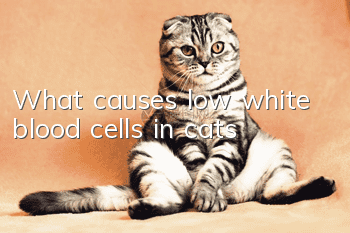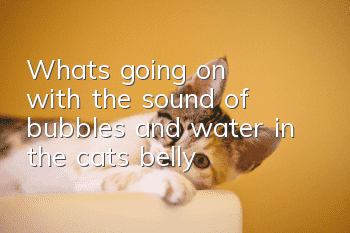What causes low white blood cells in cats?

We have always been very concerned about the treatment of certain diseases, but due to various reasons, we have neglected routine physical examinations and prevention.
Of course, this situation has gradually changed in recent years. Not only do we humans take the initiative to go to the hospital for a full body check-up, some cat owners will also take their cats to the hospital for a full-body check-up.
Talking about physical examinations is really unsettling. Whether during the physical examination or when the final report sheet comes out, people will be worried about themselves or the cat. What do you think they should do if they have some bad disease?
It is actually normal to have such worries, but worrying too much can cause a lot of jokes. For example, I accompanied a friend to take his cat to the hospital for a physical examination. As a result, when the final physical examination report came out, this tall man who was about 1.8 meters tall had his legs shaking.
I quickly asked what was going on? He told me that he saw in the physical examination report that the number of white blood cells and neutrophils in the cat was increased, and he was afraid that he had some inflammation.
At that time, I took a look at the physical examination report and felt that the situation was not too serious. I wanted to express some relief, but unexpectedly my friend picked up the physical examination report and ran directly to the doctor's office. Later, when I rushed to the office out of breath, I actually found my friend sitting on the bench with an obedient expression, listening to the doctor's instructions. The cat was actually fine.
Does a cat have inflammation if the number of white blood cells increases? Does it need to be cured immediately? Professional veterinarians tell you, don’t panic, there are still many differences.
According to veterinarians, elevated white blood cells or elevated neutrophils in cats are generally divided into the following three situations.
1. Stress-induced leukocyte elevation.
In this case, the cat is not actually sick, but is experiencing a certain amount of psychological stress or tension for some reason. For example, the cat may have become stressed after being brought to the hospital by a poop scooper and faced with a strange environment and strange humans.
After a cat experiences a certain amount of stress, its body will secrete corresponding hormones and activate corresponding mechanisms. This mechanism is similar to the mechanism used to deal with disease invasion. The physical examination report will directly show an increase in white blood cells and neutrophils.
In fact, it is very simple for the shit shovel to judge this phenomenon. Stress-induced leukocyte elevation is mainly manifested by the increase of mature neutrophils, but this increase generally does not exceed double the upper limit. Accompanying the increase in neutrophils is a decrease in lymphocytes in cats, which is also the main feature of stress leukopenia.
2. Physiological leukocyte elevation.
If the increase in stress leukocytes is caused by cats secreting hormones in response to stress, thenPhysiological leukocyte elevation is caused by cats secreting a large amount of hormones in order to resist a large amount of stress. To put it bluntly, the former is caused by the cat being a little panicked, while the latter is caused by the cat being very panicked.
Although both are caused by stress and tension, the manifestations of physiological leukocyte elevation and stress leukocyte elevation are completely different. From the physical examination report, we can clearly see that the cat's white blood cells have increased, neutrophils have also increased to a certain extent, and HCT and platelets have increased.
Because the cat is overly nervous at this time, the body will judge it as a large-scale invasion of the disease, so the spleen will release lymphocytes, which will show an increase in lymphocytes on the physical examination report. This is also a judgment of physiological white blood cells. An important difference between leukocytosis and stress leukocytosis. In addition, cats also have a certain chance of experiencing an increase in basophils and eosinophils.
3. Acute inflammation.
When seeing the words acute inflammation, I believe everyone understands that this situation is no better than the previous two situations. This is a real problem with the cat.
The increase in white blood cells in acute inflammation is different from the increase in white blood cells in the previous two situations. The first two situations are just defense mechanisms triggered by the cat's body under the influence of stress. They are equivalent to a simple test, and the number of white blood cells will not increase much.
But if the cat suffers from acute inflammation, the invasion of the disease will be real, so the white blood cells will continue to increase, and the performance on the physical examination report will rise sharply. Corresponding to the white blood cells, the cat's neutrophils, as the body's bodyguards, will naturally be mobilized, and can basically reach twice or more than the normal upper limit.
The occurrence of inflammation may also cause the cat's monocytes to increase and lymphocytes to be eliminated.
The above three situations will cause an increase in the cat’s white blood cells, but don’t think that this is the end of the matter. Finally, the veterinarian told us that there is another situation that we should pay attention to, that is, a sharp decrease in the cat’s white blood cells.
Although an increase in the cat’s white blood cells may indicate the possibility of disease, a sharp decrease in the cat’s white blood cells may indicate the worsening of the disease.
This is like fighting a war. The number of white blood cells and neutrophils as body guards continues to increase, which at least proves that the disease has not completely invaded. However, if all our own soldiers are wiped out or suffer heavy casualties, it means that the enemy is too strong and his body can no longer bear it.
Therefore, when a cat experiences severe inflammation or physical deterioration, the white blood cells and neutrophils in the physical examination report will drop sharply, and may be accompanied by a sharp drop in lymphocytes.
Having said so much, I believe everyone has a general understanding of the elevated white blood cells in cats. But I also know that like white blood cellsIndicators such as , lymphocytes, and neutrophils are difficult for ordinary people to understand at once, and we must have a basic reference data to judge the increase.
Hey, don’t worry, I will provide you with the normal standards for routine blood tests of cats and dogs as a reference.
Of course, I still have to remind you that the above content is just to tell you that the feline cat owners should know more about the various indicators of the cat’s body and the corresponding disease knowledge, so that they can distinguish the differences and avoid being like me. A situation arises where a friend scares himself.
- The 5 most suitable cat breeds for novice owners, with Siamese cats ranking first and Ragdolls ranking third
- What is better for kittens to eat?
- What to do about cat constipation Solutions to cat constipation
- How to prevent miscarriage in Shandong lion cats
- How to care for a sick Siamese cat?
- How to rescue a cat from hypothermia
- Can cat plague be cured on its own?
- How to train a Siamese cat to do somersaults
- What's wrong with cats eating chicken livers?
- What causes diarrhea and vomiting in cats



